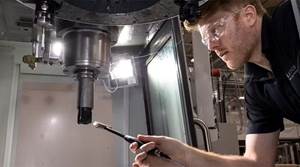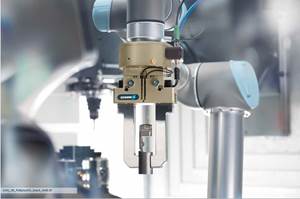Close Tolerance Manufacturer Finds The Right Cam System
When Ray and John Connelly's father, Leroy, founded Connelly Machine Works fifty years ago, he probably never envisioned using water to machine parts. Today, the Connellys have discovered how to reduce the time and cost of traditional machining using an abrasive waterjet.
Share





When Ray and John Connelly's father, Leroy, founded Connelly Machine Works fifty years ago, he probably never envisioned using water to machine parts. Today, the Connellys have discovered how to reduce the time and cost of traditional machining using an abrasive waterjet.
Connelly Machine Works is a family-owned and operated shop based in Santa Ana, California. They employ 20 people at their 10,000 square foot facility and offer an array of machining, welding and grinding services to the aerospace and other commercial industries. Equipment used at Connelly includes CNC and conventional mills, lathes, saws, welding and grinding machines.
Connelly's senior management concluded earlier this year that the shop needed to streamline its traditional machining process. Previously, parts were cut to near net with a saw and machined to finished tolerance on a CNC mill. This often required multiple passes, or wire EDM. "Time was a big disadvantage to this approach," said Ray Connelly. "It tied up our milling machines and EDM was too expensive and slow."
Intent on purchasing a wire EDM, the Connellys attended a trade show in Los Angeles. However, instead of the intended wire EDM, the Connellys purchased the Bengal abrasivejet machining center manufactured by Flow International Corp., in Kent, Washington.
They were pleased to discover that the Bengal would net and near net parts to ±0.006-inch accuracy from virtually any flat material up to four inches thick. Compact in size, the fully-integrated machining center is equipped with the Windows-based FlowMaster PC controller, the Paser 3 abrasive waterjet, an X-Y motion system, a 40,000 lb per square inch (psi) pump and a 39 inch by 19.6 inch worktable.
Connelly machines stainless and carbon steel, Inconel, titanium and brass with its abrasivejet machine. "When we saw what the Bengal could do, how fast it could cut and how easy it was to operate, we were convinced it was machined for us," said John Connelly.
"We now hog parts out in one pass with the Bengal and machine them to finish tolerance in a single pass with our CNC mills," said Ray Connelly. "And, we can use the same program on both the Bengal and the CNC mill. All we do is change the offsets."
The shop also utilizes the Bengal for other applications. "The machine is very good for prototyping and short run production. The simplicity of the software makes it an excellent machine for prototyping."
This ease of operation was a major factor in Connelly's decision to purchase the Bengal. The FlowMaster controller is pre-programmed with cutting parameters for a variety of materials, dramatically simplifying abrasive waterjet machining. To produce parts from a DXF or CAD file, users select material type and thickness and click on icons to execute waterjet commands. The controller determines optimum cutting parameters for the application. No special knowledge of abrasivejet machining or CNC programming is necessary.
"My daughter just started working at the shop," said Ray Connelly. "She has no programming experience, though she is familiar with PCs. She was able to program the Bengal, including complex parts within one week."
FlowMaster includes a CAD/CAM package and drawing functions. An optional scanner makes it possible to scan a drawing into FlowMaster where users can convert it to a DXF file in minutes. All components of the Bengal are controlled through FlowMaster.
Abrasivejet machining offers several key benefits to machine and job shops. A cold-cutting process, abrasivejet machining leaves a finished edge free of a heat-affected zone (HAZ). Consequently, abrasivejet machining reduces or eliminates secondary operations. Cutting without heat also protects against metallurgical changes, leaving the material structure of the part intact. "We previously consumed a lot of tooling trying to penetrate edges hardened by HAZ," said Ray Connelly. "An edge machined with abrasive waterjet is very easy on inserts and bits."
Abrasivejet is also said to improve material utilization, cutting from the edge or middle of a plate along specified lines in any direction. Minimal kerf (0.030 to 0.060 inch) width of the abrasivejet adds to the material savings. "The Bengal consumes much less material than saw cutting," said Ray Connelly. "We nest the parts pretty tight and definitely get more parts from a piece of material."
Set up for the abrasivejet takes less than five minutes. Tooling consists of an orifice and mixing tube, both lasting in excess of 120 hours. No tooling alignment is necessary and fixturing is minimal. "Set up time is very low," said John Connelly. "Our fixturing is very simple, one or two clamps or sometimes none at all."
Easy maintenance and uptime are other advantages. "Our machine has been running ten hours a day, six days a week. We run every minute of the day we're open. Maintenance is not a problem," said Ray Connelly. Operating cost amounts to approximately $19 per hour, excluding labor.
Related Content
How to Mitigate Chatter to Boost Machining Rates
There are usually better solutions to chatter than just reducing the feed rate. Through vibration analysis, the chatter problem can be solved, enabling much higher metal removal rates, better quality and longer tool life.
Read MoreQuick-Change Tool Heads Reduce Setup on Swiss-Type Turning Centers
This new quick-change tooling system enables shops to get more production from their Swiss turning centers through reduced tool setup time and matches the performance of a solid tool.
Read MoreInside a CNC-Machined Gothic Monastery in Wyoming
An inside look into the Carmelite Monks of Wyoming, who are combining centuries-old Gothic architectural principles with modern CNC machining to build a monastery in the mountains of Wyoming.
Read MoreLean Approach to Automated Machine Tending Delivers Quicker Paths to Success
Almost any shop can automate at least some of its production, even in low-volume, high-mix applications. The key to getting started is finding the simplest solutions that fit your requirements. It helps to work with an automation partner that understands your needs.
Read MoreRead Next
Last Chance! 2025 Top Shops Benchmarking Survey Still Open Through April 30
Don’t miss out! 91ÊÓƵÍøÕ¾ÎÛ's Top Shops Benchmarking Survey is still open — but not for long. This is your last chance to a receive free, customized benchmarking report that includes actionable feedback across several shopfloor and business metrics.
Read MoreMachine Shop MBA
Making Chips and 91ÊÓƵÍøÕ¾ÎÛ are teaming up for a new podcast series called Machine Shop MBA—designed to help manufacturers measure their success against the industry’s best. Through the lens of the Top Shops benchmarking program, the series explores the KPIs that set high-performing shops apart, from machine utilization and first-pass yield to employee engagement and revenue per employee.
Read MoreAMRs Are Moving Into Manufacturing: 4 Considerations for Implementation
AMRs can provide a flexible, easy-to-use automation platform so long as manufacturers choose a suitable task and prepare their facilities.
Read More





















